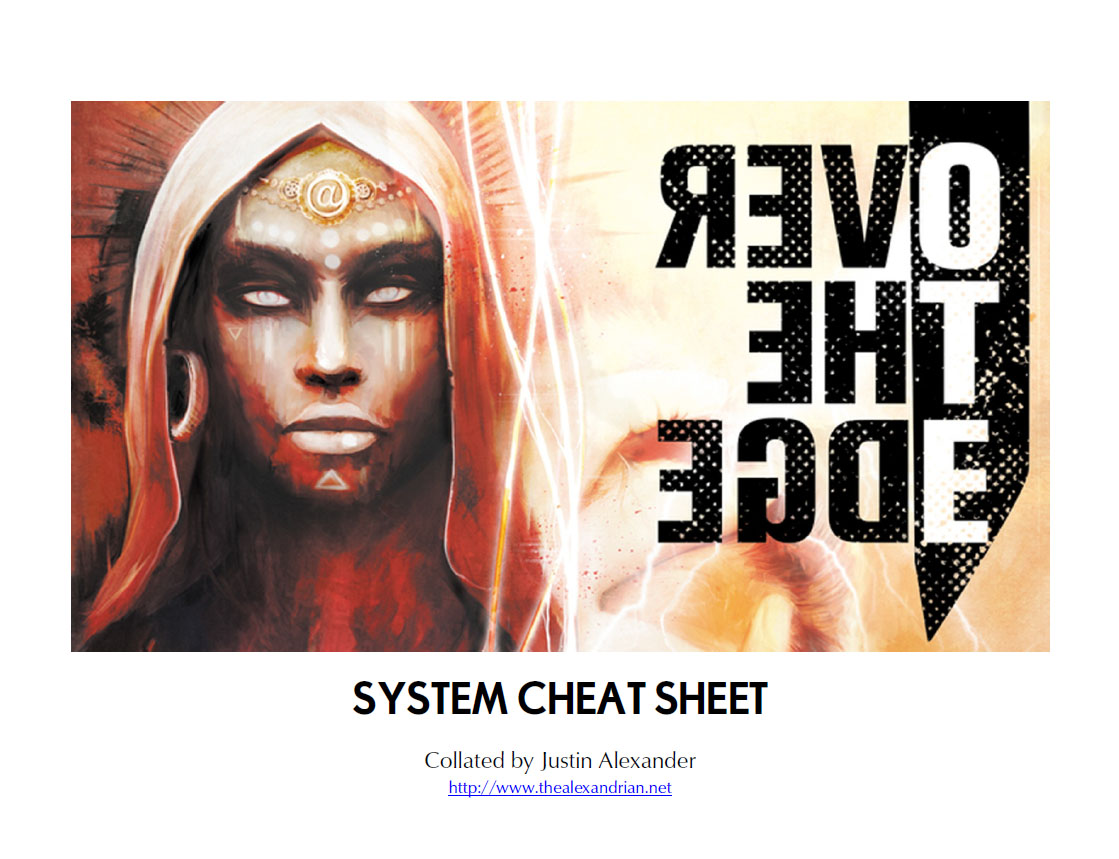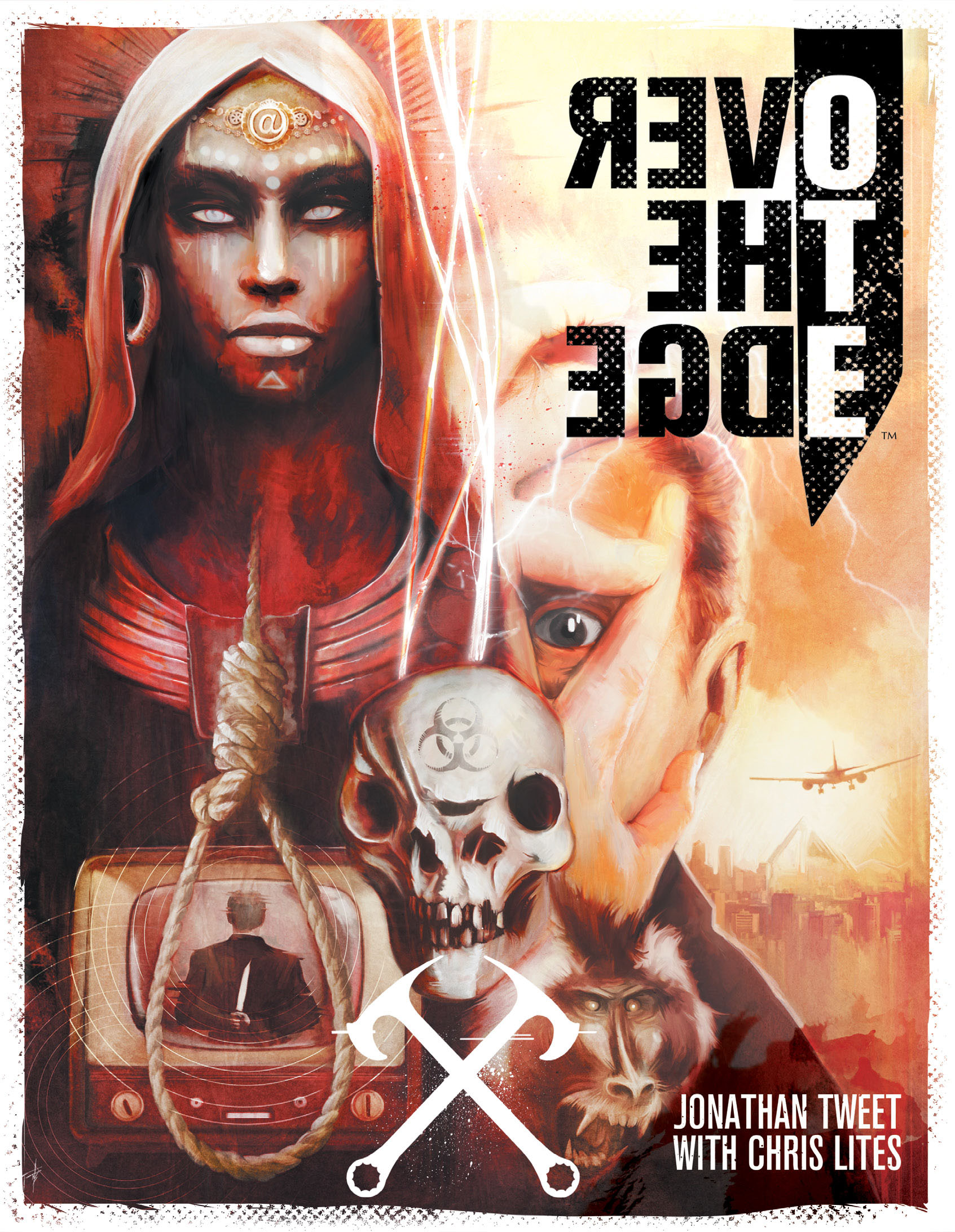The Ultimate Democratic Republic of Al Amarja welcomes you. During your stay with us please remember that Liberty is Job One, Disarmament Means Peace, It’s Polite to Speak English, and, of course, Paranormal Activity is Perfectly Legal.
Thank you for your consent.
The Edge is the weirdest city in the world. Get into trouble. Question your place in the crazed multiverse. Take a draught of madness. Peer through the gap in the mismatched angles where reality ends. Fight a baboon. Take a leap…
… over the Edge.
Over the Edge is Jonathan Tweet’s original game of enigma and conspiracy. It’s a cornucopia of fringe science, conspiracy, and hyper-reality that — in balancing on a precipice somewhere between madness and tomorrow — creates an undeniably unique frisson at the gaming table. The brand new 3rd Edition has been completely reimagined for a new generation of roleplayers: Every conspiracy has been twisted to a new angle. Every GMC
The game system, too, has been rebooted. The original game was a cutting edge system in 1992, and Tweet has reinvented that system from the bottom up to take advantage of his nearly 30 years of personal expertise in game design. The new system features fast, dramatic character creation that’s laser-focused on creating dynamic, active characters. Particularly notable in their elegance are each PC’s Trouble and Question, which relentlessly drive the story forward.
A simple 2d6 resolution mechanic uses a lightning-fast comparison of level and difficulty to generate rerolls, creating mechanical interest at the table without bogging down the action. (Which is further encouraged by the game’s focus on narrative resolution over action resolution.) The potential blandness of such simplified mechanics is counteracted by injecting shocking, unexpected outcomes through good twists, bad twists, and “twist ties”.
If you’re not familiar with these system cheat sheets, you should know that the goal is to summarize all the rules of the game – from basic resolution to the spot rules for actions, combat, firearms, injury, and the like. It’s a great way to get a grip on a new system, introducing new players to the game, and providing a long-term resource for both GM and players. (For more information on the methods I use for prepping these sheets, click here.)
WHAT’S NOT INCLUDED
These cheat sheets are not designed to be a quick start packet: They’re designed to be a comprehensive reference for someone who has read the rulebook and will probably prove woefully inadequate if you try to learn the game from them. (On the other hand, they can definitely assist experienced players who are teaching the game to new players.)
The cheat sheets also don’t include what I refer to as “character option chunks” (for reasons discussed here). In other words, you won’t find the rules for character creation here.
HOW I USE THEM
I generally keep a copy of my system cheat sheets behind my GM screen for quick reference and I also place a half dozen copies in the center of the table for the players to grab as needed. The information included is meant to be as comprehensive as possible; although rulebooks are also available, my goal is to minimize the amount of time people spend referencing the rulebook: Finding something in 6 pages of cheat sheet is a much faster process than paging through a 400 page rulebook. And, once you’ve found it, processing the streamlined information on the cheat sheet will (hopefully) also be quicker.
In the case of Over the Edge, the rules are a high-efficiency, ultra-streamlined experience. As such, the division of the cheat sheet is very straightforward: One page contains the core mechanics. The other contains the comprehensive guidelines for defining power levels. That’s all it takes.
MAKING A GM SCREEN
These cheat sheets can also be used in conjunction with a modular, landscape-oriented GM screen (like the ones you can buy here or here).
For more complicated cheat sheets I use reverse-duplex printing in order to create sheets that I can tape together and “flip up” to reveal additional information behind them. Since the Over the Edge cheat sheet is only two pages long, that’s obviously not necessary. If you have a four-panel screen like myself, you might consider sliding Axel Ortiz‘ beautiful map of the Edge into one of the slots. You might also consider adapting the Al Amarjan Names Handout (which can be found here).













